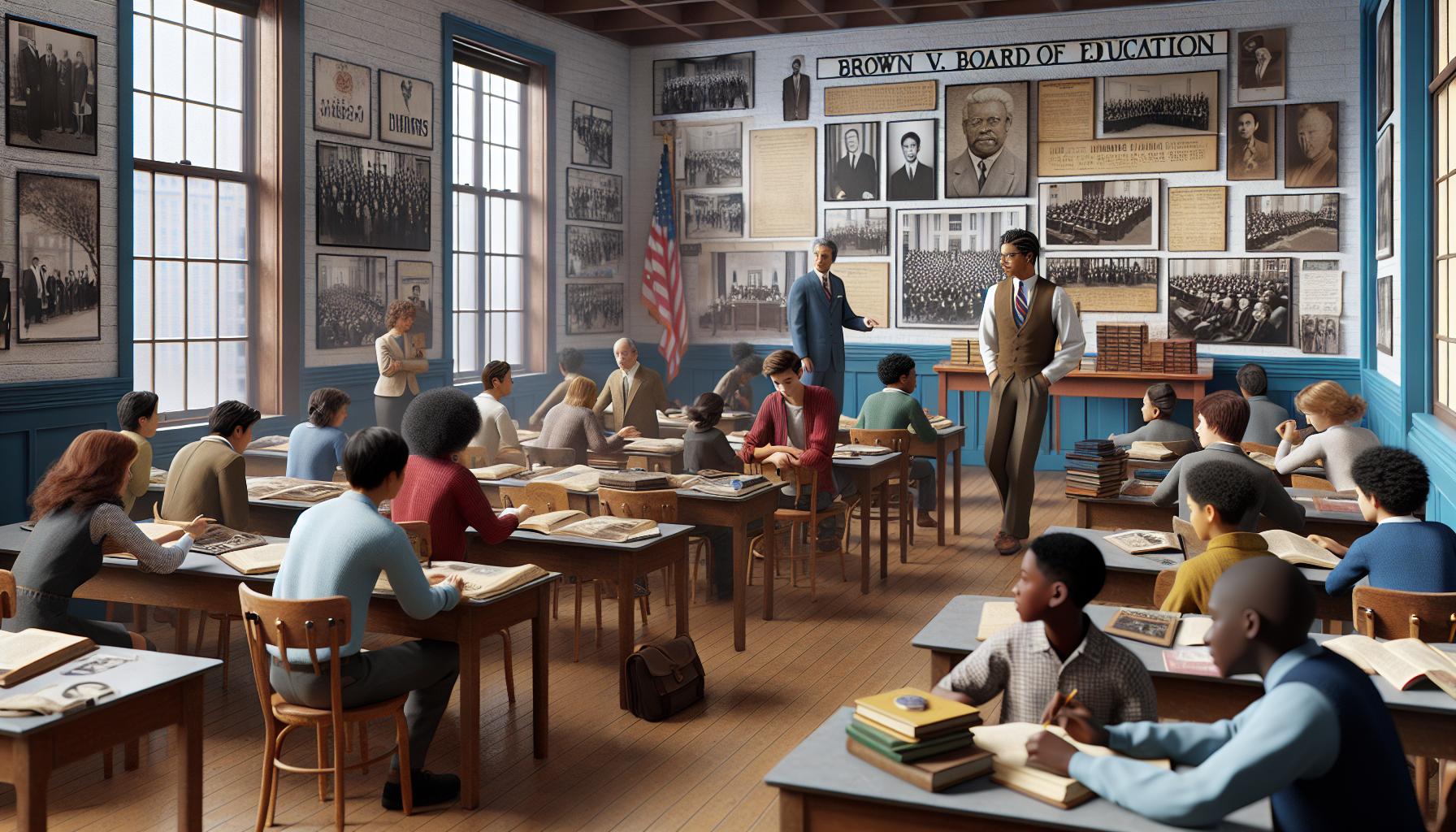The landmark case of Brown v. Board of Education reshaped the landscape of American education and civil rights. It challenged the status quo of racial segregation in schools and paved the way for a more equitable society. Understanding this pivotal moment in history is crucial for grasping the ongoing struggle for equality.
When I dive into the details of Brown v. Board of Education, I find it fascinating how a single court decision can influence generations. Using tools like Quizlet can help anyone grasp the key concepts, terms, and implications of this case. Whether you’re a student, educator, or history enthusiast, engaging with this material can deepen your understanding of its significance and impact on today’s educational system.
Key Takeaways
Landmark Decision: Brown v. Board of Education was a Supreme Court case that declared state-sponsored segregation in public schools unconstitutional, overturning the “separate but equal” doctrine established by Plessy v. Ferguson.
Historical Context: The case emerged in the post-World War II era, highlighting the persistent racial segregation and inequality affecting African American families’ access to education in the United States.
Equal Protection Clause: The Court’s ruling emphasized that segregation violated the Equal Protection Clause of the Fourteenth Amendment, marking a pivotal moment for civil rights.
Legal and Social Impact: The decision catalyzed future civil rights legislation, influencing laws such as the Civil Rights Act of 1964 and the Voting Rights Act of 1965, and promoting ongoing advocacy against racial discrimination.
Quizlet Learning Tools: Utilizing Quizlet features like flashcards, study guides, and interactive quizzes can effectively enhance understanding of key concepts and figures related to Brown v. Board of Education.
Engagement and Retention: Interactive resources available on platforms like Quizlet create an engaging learning environment, making complex historical events easier to understand and remember.
Brown v Board of Education Quizlet
Brown v. Board of Education is a pivotal Supreme Court case that reshaped the American educational landscape. This case tackled the constitutionality of racial segregation in public schools and underscored the need for equality in education.
Historical Context
Brown v. Board of Education emerged in a post-World War II United States marked by heightened awareness of civil rights. Despite the success of the war, racial segregation persisted, especially in the South, affecting African American families’ access to quality education. The case originated from a series of lawsuits against school districts in Kansas, South Carolina, Virginia, and Delaware, collectively challenging the doctrine of “separate but equal” established in Plessy v. Ferguson (1896). The social and political climates of the 1940s and 1950s, combined with grassroots activism, set the stage for a legal challenge that would transform America.
Key Legal Issues
Several legal issues framed the arguments in Brown v. Board of Education. The core argument centered on whether state-sponsored segregation in public education violated the Equal Protection Clause of the Fourteenth Amendment. Evidence presented highlighted psychological studies demonstrating the adverse effects of segregation on African American children. The Court’s unanimous decision, announced on May 17, 1954, concluded that “separate educational facilities are inherently unequal,” thus overturning Plessy v. Ferguson’s precedent. This decision marked a critical turning point in the civil rights movement and laid the groundwork for future anti-discrimination laws.
Significance of the Case


Brown v. Board of Education profoundly reshaped the landscape of American civil rights and education. The case’s rulings influenced laws and social attitudes towards racial equality.
Impact on Segregation Laws
Brown v. Board of Education directly challenged and overturned the “separate but equal” doctrine from Plessy v. Ferguson. The Supreme Court’s unanimous decision declared that state-sponsored segregation in public schools violated the Equal Protection Clause of the Fourteenth Amendment. This landmark ruling invalidated segregation laws across various states, prompting swift changes in educational policies. Schools began to implement desegregation plans, leading to significant shifts in how education was accessed and delivered to African American students and others affected by segregation.
Influence on Future Legislation
The decision in Brown v. Board of Education served as a catalyst for civil rights legislation in the 1960s. It laid the groundwork for future laws that prohibited discrimination based on race, ethnicity, and other characteristics. Legislation such as the Civil Rights Act of 1964 and the Voting Rights Act of 1965 drew inspiration from the case, emphasizing the necessity of equality in all public domains. The case also inspired communities to pursue legal avenues in fighting against racial discrimination, establishing a framework for subsequent legal challenges to segregation and inequality across various civil rights arenas.
Quizlet Resources


Quizlet offers a variety of resources that make learning about Brown v. Board of Education engaging and effective. These tools facilitate understanding of key concepts and help reinforce knowledge through interactive methods.
Study Guides and Flashcards
I recommend using Quizlet’s study guides and flashcards designed specifically for Brown v. Board of Education. These tools present significant terms, key figures, dates, and concepts in a concise format. Users can create custom flashcards for specific study needs, allowing personalized review sessions. Examples include flashcards highlighting main arguments, important quotes from the decision, and impacts on subsequent civil rights cases. By revisiting these flashcards regularly, learners can reinforce their memory and comprehension.
Interactive Learning Tools
Quizlet features several interactive learning tools, including games and practice quizzes, that make studying dynamic. Users can engage in activities like “Match” and “Gravity,” where they can test knowledge of important case details while competing against themselves or others. Additionally, practice quizzes provide immediate feedback, allowing users to identify areas for improvement. These interactive options not only enhance retention but also make learning about Brown v. Board of Education a more enjoyable experience.
Common Themes in Quizlet Resources


I recognize several common themes in Quizlet resources related to Brown v. Board of Education that enhance understanding and engagement.
- Historical Context: Quizlet materials often provide a timeline outlining key events leading up to the case. This context aids comprehension, illustrating the social and legal landscape of the 1950s.
- Key Figures: Quizlet flashcards frequently highlight prominent individuals involved, such as Thurgood Marshall and the plaintiffs from Topeka. Knowing these figures personalizes the historical narrative and emphasizes their contributions to civil rights.
- Legal Concepts: Many resources clarify critical legal principles, including the Equal Protection Clause of the Fourteenth Amendment. Simplifying these concepts enhances accessibility for a diverse audience.
- Impact Analysis: Quizlet quizzes often encourage reflection on the case’s far-reaching implications. Resources prompt discussions about subsequent civil rights legislation and the ongoing fight for equality.
- Engagement Tools: Interactive features like matching games and practice tests in Quizlet foster active learning. These tools increase student participation and retention of crucial information.
These themes create a comprehensive learning experience, making an important historical event relatable and easier to grasp through collaborative and interactive methods.
Brown v. Board of Education
Understanding Brown v. Board of Education is essential for grasping the ongoing struggle for equality in education. This landmark case didn’t just change the legal landscape; it inspired generations to fight against injustice. By utilizing tools like Quizlet, I can enhance my grasp of the case’s complexities and its profound implications on civil rights.
The resources available make learning engaging and effective, ensuring that the lessons from this pivotal moment in history remain relevant today. As I continue to explore the themes and impacts of this case, I’m reminded of the importance of advocating for equality in all aspects of life.
